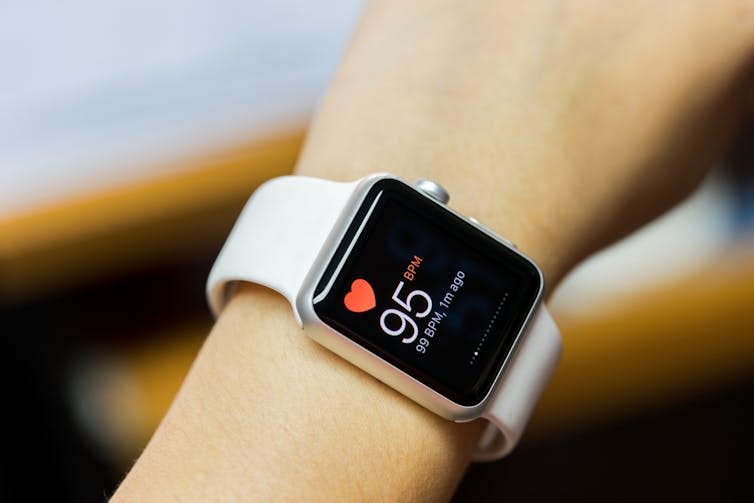Web and mobile services try to understand users’ wants and goals by analyzing how users interact with their platforms. For example, smartphones capture online data from users at scale and at low cost.
Policymakers have reacted by implementing mechanisms to reduce risks from technology companies storing and processing citizens’ private information, such as health data.
Wearable devices are now becoming a more important element of this discussion due to their ability to continuously collect data without the user being aware. Wearable devices like smartwatches collect a range of metrics about your health, such as your sleep patterns, activity level and heart condition.
Nowadays, portable devices are available to obtain high-quality data from brain activity, eye trackers, and skin (to detect temperature and sweat). Consumers can purchase small devices that measure the body’s responses and were available only to research institutions only a few decades ago.
While wearable devices have commercially focused on monitoring health, researchers have long envisioned capturing other types of data about a user. A computer that can gather useful information about a person’s brain activity, heart and skin function, or movement patterns can understand a lot about the user.
But what will change the rules of the game is artificial intelligence. Smaller wearable devices combined with artificial intelligence algorithms to process data can produce tools that empower and enhance our goals and performance in life. But all this information gathering has its drawbacks.
Daily routines
Let’s imagine a world where wearable devices play an increasingly prominent role every day. By reading our body temperature, respiration and brain activity, smart beds can wake us up at the perfect time to feel rested. Smart kitchens can help us eat healthier by preparing a personalized diet based on chemical signatures (biomarkers) in our bloodstream. A smart bike will automatically change gears according to the changing slope of the terrain and our fitness level to support an effective workout.
By analyzing the reactions of the pupils in our eyes and our general eye movements, smart glasses can present us with content we will enjoy (powered by AI algorithms). Video calls can turn into 3D full-body holograms of your friends and family. Finally, immersive entertainment can be projected into our living rooms or brought into existence through headphones, becoming 360-degree experiences rather than being limited to flat screens.

Although it may seem futuristic, hardware manufacturers are already trying to take screens and devices away from us. For example, at Mobile World Congress 2024, various smartwatches were exhibited, an AI “pin” device produced by the company Humane that can eliminate the need for a screen by projecting images onto the user’s hands, or Air Glass 3 XR smart glasses.
Other companies have also recently introduced head-worn devices such as the Ray-Ban Meta, Apple Vision Pro or Meta Quest 3. The device, known as the Galea project, is a type of helmet that can be attached to XR headsets to capture images. data from facial muscles, brain, eyes, skin and heart.
This is clearly more invasive than a smart ring or smart glasses. It allows researchers to explore what future digital services might look like if computers could access various data from the human body. This data, like what we do on our smartphones, will go far beyond what we can access now.
Body data from wearable devices in general could fundamentally change the way we interact with computers and the internet. In 2007, audiences at an Apple product launch were in awe as Steve Jobs swiped on an iPhone for the first time, introducing an intuitive interaction that the world would eventually adopt.
Similarly, replacing smartphones with wearables and headsets will free our hands and require new types of interactions with technology. Current prototypes suggest using the gaze of our eyes and hand gestures in the air to point while in the air to click. However, this means that these systems must constantly collect data about the user’s body.
digital sovereignty
Large data sets based on responses from the human body can unlock the design of digital tools that seamlessly weave our daily lives with highly personalized capabilities. This includes a smart bed and a smart kitchen that can recommend a personalized diet.
The next wave of the internet is being designed around the centralization of data, where users can potentially have more control over how their data is used. This can prevent misuse of personal information.
For example, Tim Berners Lee, the inventor of the World Wide Web, is working on something called Solid. This open source initiative allows people to process their data on personal web servers and choose which organizations can access that data.
Rather than making people create an account for every service they want to use, Solid will provide a protocol for creating what the project calls personal online data stores. This could be a way to enable users to host their personal data on their own computers, or alternatively to choose a trusted provider to host that data based on their reputation and physical location.
But to truly strengthen these initiatives, proactive legislation on digital sovereignty (the right to control one’s own digital data) will be required. This ensures an internet that truly takes privacy seriously.
In the age of wearable devices and powerful artificial intelligence systems, a decentralized approach to the internet is vital to enable citizens to reap the benefits of these technological advances while continuing to own their own data. This will move us towards the ability for citizens to make active decisions about where their data is stored, who can access it and for what purposes.
This article is republished from The Conversation under a Creative Commons license. Read the original article.


Luis Quintero does not work for, consult, own shares in, or receive funding from any company or organization that would benefit from this article, and has disclosed no relevant affiliations beyond his academic duties.